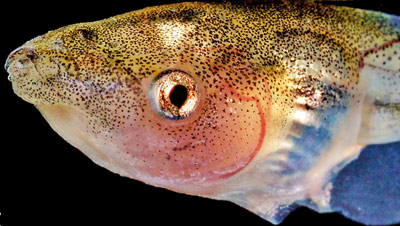News
Toxic frog joins elite endemic club

The Mihintale narrow-mouthed frog and below, the tadpole of this frog
Mihintale is recognised as one of the world’s oldest wildlife sanctuaries, so it is fitting that a new frog found to be endemic to Sri Lanka has been named after Mihintale to honour its ancient values.
“On top of being a historic sanctuary, Mihintale is also the point of unison for two ancient cultures, when Mahinda Thera (Son of Indian Emperor, Asoka) met Dewanampiya Tissa (the king of Anuradhapura, Sri Lanka) in 246 BC. Hence we named the frog Microhyla mihintalei”, Dr. Madhava Meegaskumbura, who led the research team, said.
This frog is now officially called the Mihintale narrow-mouthed frog (Microhyla mihintalei). The specie is found mainly in the lowland dry zone and also has a small presence in some parts of the Wet Zone. The specimens these scientists used for their study lived near Mihintale.
As its name implies, the frog has a narrow mouth that restricts its diet to smaller prey such as termites and other ants. It is reddish in colour and a little bigger than Microhyla ornata (ornate narrow-mouthed frog) the other species in Sri Lanka that can be confused with this species.
The females are bigger – up to 2 inches, while males can be 1.5 inches.
Being in proximity, Sri Lanka and India share many wild species. But as a result of thousands of years of separation due to the sea barrier, Sri Lankan populations of a number of amphibians evolved to become unique to the island.

Tadpole of Microhyla mihintalei - MadhavaM
The Mihintale frog had been previously considered to be a species called Microhyla rubra that is widespread in India and Sri Lanka.
Being a dry zone species, the Mihintale frog has to wait for torrential rains to breed. They lay floating layers of eggs on the surface of rainwater pools. The tadpoles have to be lucky to become transformed into frogs before the water pool runs dry.
The skin of this frog is toxic, so many predators avoid it, giving the species a greater chance of survival.
Unlike other endemic frogs, the population of Mihintale frog is considered stable.
The reporting of this endemic species is yet another success story of joint research by Sri Lankan and Indian scientists.
The discovery was published in the Zootaxa journal with research being carried out by graduate students Nayana Wijayathilaka, Sonali Garg, Gayani Senevirathne, Nuwan Karunarthna under the supervision of Dr. Madhava Meegaskumbura of University of Peradeniya and India’s frog expert, Prof. S.D. Biju.
There are 118 frogs and toads
in Sri Lanka and with the new member, 102 of them are endemic to Sri Lanka.

